翻译研究之2:跨文化交际—翻译理论与对比篇章语言学(Basil Hatim)
西方翻译研究的新发展(英语论文)
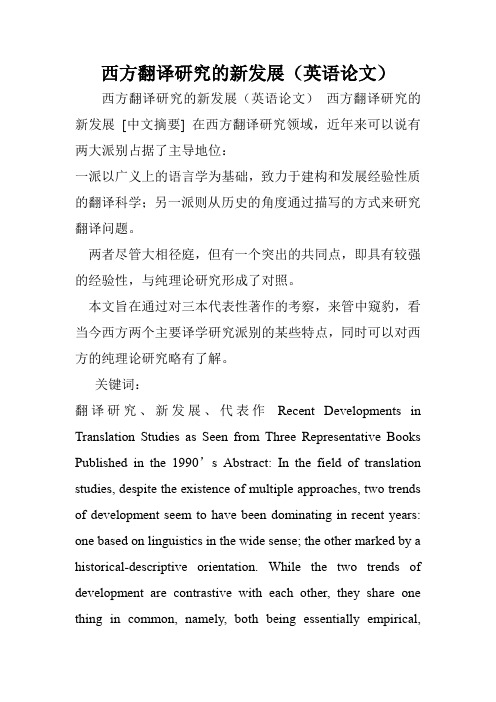
西方翻译研究的新发展(英语论文)西方翻译研究的新发展(英语论文)西方翻译研究的新发展[中文摘要] 在西方翻译研究领域,近年来可以说有两大派别占据了主导地位:一派以广义上的语言学为基础,致力于建构和发展经验性质的翻译科学;另一派则从历史的角度通过描写的方式来研究翻译问题。
两者尽管大相径庭,但有一个突出的共同点,即具有较强的经验性,与纯理论研究形成了对照。
本文旨在通过对三本代表性著作的考察,来管中窥豹,看当今西方两个主要译学研究派别的某些特点,同时可以对西方的纯理论研究略有了解。
关键词:翻译研究、新发展、代表作Recent Developments in Translation Studies as Seen from Three Representative Books Published in the 1990’s Abstract: In the field of translation studies, despite the existence of multiple approaches, two trends of development seem to have been dominating in recent years: one based on linguistics in the wide sense; the other marked by a historical-descriptive orientation. While the two trends of development are contrastive with each other, they share one thing in common, namely, both being essentially empirical,forming a contrast to translation studies with a somewhat ‘purely’theoretical orientation. The present paper offers a discussion of some recent developments in the field by way of reviewing three representative books published in the 1990’s. Through the present review, we may get a glimpse not only of the characteristics of the two major trends of development, but also of certain features of the theoretical versus the empirical orientation. Key words: translation studies, developments, representative books 20世纪80年代初以来,西方翻译研究进展迅速。
Basil Hatim 巴兹尔 哈蒂姆
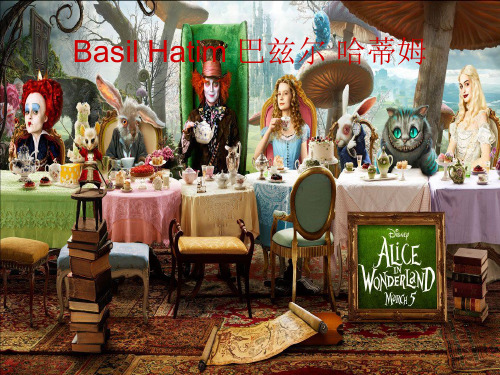
语境与翻译
语境是让话语具有连贯性(coherence)的所 有因素中最活跃,最多变的因素 哈蒂姆把语境分为三类 交际维度(communicative dimension)研究 语言变体产生的条件 语用维度(pragmatic dimension)研究语言 行为意图等 符号维度(semiotic dimension)研究把交际 实体及其语用含义放在整个符号系统中
Basil Hatim 巴兹尔 哈蒂姆
巴兹尔 哈蒂姆
• 巴兹尔•哈蒂姆,篇章语言学领域的著名理论家和学术带 头人。对话语分析及翻译等领域的研究有很深造诣。自 1980年以来,他一直担任爱丁堡赫里奥特——沃特 (Heriot-Watt)大学阿拉伯语研究中心主任,并曾在英国、 欧洲大陆及中东地区巡回讲学,演讲内容主要是从翻译的 角度剖析修辞学和现代篇章语言学。 • 他是篇章语言学领域的著名理论家,注重语篇分析在翻译 中的应用,认为翻译不只是一种单纯的语际转换活动,而 是在一定社会情景中发生的交际过程。译者只有具备双语 能力和双文化视野,才能当好跨文化交际中的协调人 (mediator)。
哈蒂姆的互文翻译理论
• 哈蒂姆认为如果互文性未能与翻译活动中复杂的 决策过程联系起来,及各种互文语篇若不能与一 套力求合适译文效果的语篇操作程序规则联系起 来,那么对于互文性的分类对翻译实践就是毫无 意义的。 • 哈蒂姆的互文性翻译理论吸纳了篇章语言学,功 能语言学,结构语言学,心理语言学,批评语言 学,语用学,符号学等多学科的研究成果,他的 翻译理论本身就充满了互文姆翻译理论
• • • • 对翻译的理解 语境与翻译 互文性与翻译 连贯与翻译
跨文化交际视角下的语言与翻译研究
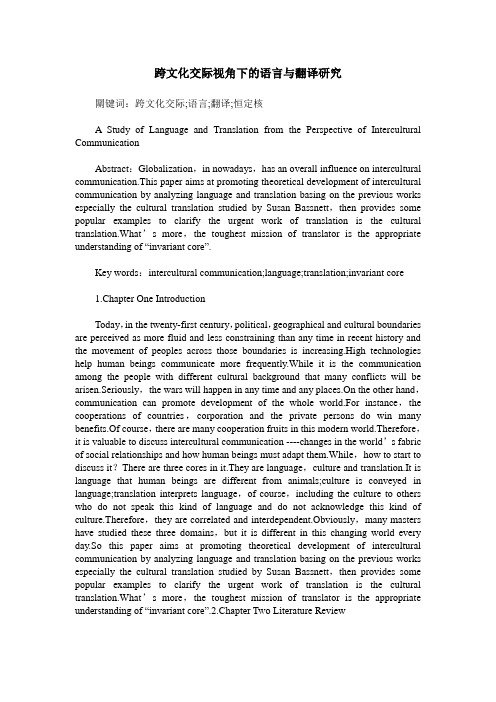
跨文化交际视角下的语言与翻译研究關键词:跨文化交际;语言;翻译;恒定核A Study of Language and Translation from the Perspective of Intercultural CommunicationAbstract:Globalization,in nowadays,has an overall influence on intercultural communication.This paper aims at promoting theoretical development of intercultural communication by analyzing language and translation basing on the previous works especially the cultural translation studied by Susan Bassnett,then provides some popular examples to clarify the urgent work of translation is the cultural translation.What’s more,the toughest mission of translator is the appropriate understanding of “invariant core”.Key words:intercultural communication;language;translation;invariant core1.Chapter One IntroductionToday,in the twenty-first century,political,geographical and cultural boundaries are perceived as more fluid and less constraining than any time in recent history and the movement of peoples across those boundaries is increasing.High technologies help human beings communicate more frequently.While it is the communication among the people with different cultural background that many conflicts will be arisen.Seriously,the wars will happen in any time and any places.On the other hand,communication can promote development of the whole world.For instance,the cooperations of countries,corporation and the private persons do win many benefits.Of course,there are many cooperation fruits in this modern world.Therefore,it is valuable to discuss intercultural communication ----changes in the world’s fabric of social relationships and how human beings must adapt them.While,how to start to discuss it?There are three cores in it.They are language,culture and translation.It is language that human beings are different from animals;culture is conveyed in language;translation interprets language,of course,including the culture to others who do not speak this kind of language and do not acknowledge this kind of culture.Therefore,they are correlated and interdependent.Obviously,many masters have studied these three domains,but it is different in this changing world every day.So this paper aims at promoting theoretical development of intercultural communication by analyzing language and translation basing on the previous works especially the cultural translation studied by Susan Bassnett,then provides some popular examples to clarify the urgent work of translation is the cultural translation.What’s more,the toughest mission of translator is the appropriate understanding of “invariant core”.2.Chapter Two Liter ature ReviewBefore talking about the relationship among them,it is vital to understand the notion of culture and intercultural communication.2.1 Definition of CultureWhen it comes to definition of culture,it is very difficult to give a certain concept of it.According to Tytler(1871),“Culture or civilization taken in its wide anthrographic sense,is that complete whole which includes knowledge,beliefs,art,morals,law,custom and any other capabilities and habits aquired by a man as a member of society.” T his definition includes spiritual aspects mostly.Then in Baidu Baike1,culture includes spiritual and material treasure created by human beings.11 kinds of conclusions about culture have been proposed by C.Kluckhohn in Mirror of Man according to abundant definition of other scholars.They are 1)the sum of lifestyle about a nation;2)social heritage that the one recieves from groups;3)pattern ofthinking,emotion and belief;4)generalization of a series of behaviors;5)as for anthropologist,it is a theory concerning about behavioral style of a group of people.6)a precious trove assembling a mountain of knowledge;7)a set of standardized cognition of a certain recurring disputable issue;8)aquiring behaviors;9)one kind of mechanism keeping the normative of acts;10)a set of technologies adjusting relationship between the one andenvironment even the other people;11)an accumulation of history.(Li Han,1999:p5)3.Chapter Three Language and Translation in Intercultural Communication3.1 Language and CultureEdward Sapir cl aims that “language is a guide to social reality” and that human beings are at the mercy of the language that has become the medium of expression for their society.Experience,he asserts,is largely determined by the language habits of the community,and each separate structure represents a separate reality:Sapir’s thesis,endorsed later by Benjamin Lee Whorf,is related to the more recent view advanced by the Soviet semiotician,Juri Lotman,that language is a modelling system.Lotman describes literature and art in general as secondary modelling systems,as an indication of the fact that they are derived from the primary modeling system of language,and declares as firmly as Sapir or Whorf that “No language can exist unless it is steeped in the context of culture;and no culture can exist which does not have at its center,the structure of natural language”.Language,then,is the heart within the body of culture,and it is the interaction between the two that results in the continuation of life-energy.In the same way that the surgeon,operating on the heart,cannot neglect the body that surrounds it,so the translator treats the text in isolation from the culture at his peril.3.2 Culture and TranslationIn his article “On Linguistic Aspects of Translation”,Roman Jakobsondistinguishes three types of translation:1.Intralingual translation,or rewording(an interpretation of verbal signs by means of other signs in the same language).2.Interlingual translation of translation proper(an interpretation of verbal signs by means of some other language).3.Inter semiotic translation or transmutation(an interpretation of verbal signs by means of signs of nonverbal sign system).Having established these three types,of which translation proper describes the process of transfer from source language to target language,Jakobson goes on immediately to point to the central problem in all types:that while messages may serve as adequate interpretations of code units or messages may serve as adequate interpretations of code units or messages,there is ordinarily no full equivalence,and Jakobson shows how intralingual translation often has to resort to a combination of code units in order to fully interpret the meaning of a single unit.Hence a dictionary of so-called synonyms may give perfect as a synonym for ideal or vehicle as a synonym for conveyance but in neither case can there be said to be complete equivalence,since each unit contains within itself a set of non-transferable associations and connotations.Because complete equivalence(in the sense of synonymy or sameness)cannot take place in any of his categories,Jakobson declares that all poetic art is therefore technically untranslatable.Only creative transposition is possible and the translation is only an adequate interpretation of an alien code unite and equivalence is impossible.As for equivalence,Popovic distinguishes four types:1.Linguistic equivalence,where there is homogeneity on the linguistic level of both source language and target language,i.e.word for word translation.2.Paradigmatic equivalence,where there is equivalence of “the elements of a paradigmatic expressive axis”,i.e.elements of grammar,which Popovic sees as beinga higher category than lexical equivalence.3.Stylistic(translational)equivalence,where there is ‘functional equivalence of elements in both original and translation aiming at an expressive identity with an invariant of identical meaning’.4.Textual(syntagmatic)equivalence,where there is equivalence of the syntagmatic structuring of a text,i.e.equivalence of form and shape.Eugene Nida distinguishes two types of equivalence,formal and dynamic,where formal equivalence ‘focuses attention on the message itself,in both form and content.In such a translation one is conrcerned with such correspondences as poetry topoetry,sentence to sentence,and concept to concept.’Nida call this type of translation a ‘gloss translation’,which aims to allow the reader to understand as much of the source language context as possible.Dynamic equivalence is based on the principle of equivalent effect,i.e.that the relationship between receiver and message should aim at being the same as that between the original receiver and the source language message.The principle of equivalent effect which has enjoyed great popularity in certain cultures at certain times,involves us in areas of speculation and at times can lead to very dubious conclusions.However,language conveys culture and culture reflects language.It is essential to understand the different kinds of culture.So translation is the bridge to combine the different cultures.Cultural translation is the vital aspect of translation in this global village.After all,the power of culture is overwhelming.But sameness does not exist according to the above researches.Then similarity is the goal of translation.So how to comprehend ‘invariant core ’is the chief mission of translator.This invariant core,Popovic claims,is represented by stable,basic and constant semantic elements in the text,whose existence can be proved by experimental elements in the text,whose existence can be proved by experimental semantic condensation.Transformations,or variants,are those changes which do not modify the core of meaning but influence the expressive form.In short,the invariant can be defined as that which exists in common between all existing translations of single works.So the invariant is part of a dynamic relationship and should not be confused with speculative arguments about the ‘nature’,the ‘spirit’or ‘soul’of the text;the ‘indefinable quality’that translators are rarely supposed to be able to capture.When cultural untranslated occurs in translation,it is necessary to catch the ‘invariant core’of source language,and then apply the translation skills to verify the core to target language.4.Chapter Four ConclusionFrom above,it is very imperative to study the theory of intercultural communication.Furthermore,it is vital to use the theory to guide the practice.In this global world,people with different cultures communicate more and more frequently,many conflicts occur in every second.One of the effective ways to solve these conflicts is translation.But how to translate appropriately?How do translators translate the unique culture to another culture?Understanding the two languages,of course,is very important.But it is more essential to catch the invariant core of the language.References[1]Bassnett,Susan.2004,Translation Studies(Third Edition).Shanghai:Shanghai Foreign Language Press.[2].W.B.Gudykunst,2005,Theorizing about Intercultural Communication,Sage Publications Inc.[3]W.B Gudykunst,“Intercultural Communication:Introduction”,in W.B.Gudykunst(eds.),Cross-cultural and Intercultural Communication,Thousand Oaks:Sage Publications,2003,p163[4]Y.Y.Kim,1988,“OnTheorizing Intercultural Communication”,in Y.Y.Kim & W.B.Gudykunst(eds.),Theories in Intercultural Communication,Newbury Park:Sage Publications:p12.[5]http:///link?url=DUVaQnM5PlWsYzV3b8qNLI5zo41qRbZ0bwDeWk9U0A9dqGZ5utQrXUWx P12hD9at7bN2_GXGVQg3nyvHwP33XK5lZCFfEso_jd-TxlHaFaS.[6]戴曉东,2011,跨文化交际理论[M],上海:上海外语教育出版社。
研究生跨文化交际方向参考书目

研究生跨文化交际方向参考书目1.邓炎昌,刘润清.《语言与文化》北京:外语教学与研究出版社,1997.5 2.胡文仲.《文化与交际》北京:外语教学与研究出版社,1998.10 3.胡文仲.《跨文化交际与英语学习》上海:上海译文出版社,1988.9 4.胡文仲.《跨文化交际面面观》北京:外语教学与研究出版社,1999.11 5.胡文仲高一虹.《外语教学与文化》湖南:湖南教育出版社,1997.3 6.胡文仲.《英美文化辞典》北京:外语教学与研究出版社,1997.3 7. 胡文仲.«跨文化交际学概论»外语教学与研究出版社,1999.11 8.Davis.«中西文化之鉴:跨文化交际教程»(Doing Culture),外语教学与研究出版社2001.19.顾曰国.«跨文化交际»(附MP3光盘1张),外语教学与研究出版社,2009.0910.Samovar、陈治安.«跨文化交际»,外语教学与研究出版社,2000.0811. 陈国明.«跨文化交际学»,华东师范大学出版社,2009.0612.胡超.«跨文化交际实用教程(语言文化类)»,外研社2006.0613. William J. Starosta.«跨文化交际学基础»,上海外语教育出版社,2007.0714.许力生、吴丽萍.«教师手册新编研究生英语系列教材•跨文化交际»,上海外语教育出版社,2008.1115.毕继万.«跨文化交际与第二语言教学»,北京语言学院出版社,2009.1216. Scollon、贾玉新.«跨文化交际;语篇分析法»,外研社,2000.01rry A.Samovae .«跨文化交际读本»(第10版),上海外语教育,2007.0118.马丁(Judith N.Martin)、中山(Thomas K.Nakayama).«社会、历史背景下的跨文化交际»(第4版),外语教学与研究出版社,2009.1019.William B.Gudykun. «跨文化与不同文化之间的交际»,上海外教社2007.08 20.樊葳葳.«跨文化交际视听说»(附MP3光盘1张),大学英语选修课/学科课程系列教材项目组高等教育出版社,2009.0321.樊葳葳,陈俊森,钟华.«外国文化与跨文化交际»(第2版),华中科技大学,2008.0522.刘凤霞.«跨文化交际教程»(第2版),北京大学出版社,2009.0323. 哈蒂姆.«跨文化交际:翻译理论与对比篇章语言学»,上海外教社,2001.0124.许力生.«新编跨文化交际英语教程»,上海外教社,2009.0725.许力生.«跨语言研究的跨文化视野»,上海外语教育出版社,2006.0526.张爱琳.«跨文化交际»,重庆大学出版社,2003.0427. 贾玉新.«跨文化交际研究(第1辑)»,高等教育出版社,2009.0628.金惠康.«跨文化交际翻译(原创版)»29. 王催春、朱冬碧、吕政.«跨文化交际»,北京理工大学出版社,2008.0830.威廉、金洋咏.«与陌生人交际-跨文化交流方法(第4版)»,上海外语教育出版社,2007.0731.林大津、谢朝群.«跨文化交际学:理论与实践»,福建人民出版社,2005.0132. 陈俊森、樊葳葳、钟华.«跨文化交际与外语教育»,华中科技大学出版社,2006.0233.多德.«跨文化交际动力(第5版)»,上海外语教育出版社,2006.1034.张红玲.«跨文化外语教学»,上海外语教育出版社,2007.0235.(美)萨莫瓦尔(Samovar,L.),(美)波特(Porter,R.)著.«跨文化交流(第5版)»,北京大学出版社,2004.071. Larry A. Samovar, Richard E. Porter Lisa A. Stefan. Communication BetweenCultures. Brooks/Cole/Thomson Learning Asia ,2000.82. Samovor L A, Porter R E.Intercultural Communication: A Reader. Belmont, CA: Wadsworth.19913.The Silent Language. Hall ET. New York: Doubleday. 19664. Hu Wengzhong.Aspects of Intercultural Communication. Beijing:Foreign Language Teaching &n Research Press, 1999.15. Gudykunst W, Kim Y Y. 2nd ed. Communicating with Strangers: An Approach to Intercultural Communication. New York: Random House. 1992.6. Hatim, basil. Communication Across Cultures: Translation Theory and Contrastive Text Linguistics. Shanghai: Shanghai Foreign Language Education Press. 20017. Beamer, Linda, Iris Varner. Intercultural Communication in the Global Workplace. Beijing: Qinghua University Press. 20038. Stewart, Edward C, Bennett Milton J.American Culture Patterns: A Cross-cultural Perspective. Beijing: Intercultural Press. 19859. Francis L K hsu. Americans and Chinese: Passage to Difference.Honolulu:University of Hawaii. 198110. Brislin, Richard W, et al. Intercultural Interaction: A Practical Guide. Sage Publications. 1986。
跨文化交际(英语)

跨文化交际课程教学大纲一、课程的基本信息适应对象:英语专业本科四年级学生课程代码:07007926学时分配:30赋予学分:2先修课程:《普通语言学》、《英美概况》、《英美文学史》、《欧洲文化入门》后续课程:二、课程性质与任务当今世界发生的翻天覆地的变化使社会对外语人才的需求也相应提高。
近年来对交际能力的要求除听、说、读、写四种语言运用能力外,还需要具备社会文化能力,即文化素养。
《跨文化交际学》是外语专业本科四年级的任意选修课程。
它以促进学生整体素质发展为根本,注重学生在技能、知识、情感、策略和文化素质等各方面的综合发展。
作为一门新兴学科,《跨文化交际学》集社会语言学、文化语言学、语用学、翻译学、传播学、人类学、外语教学等领域的研究成果于一体,着重文化与交际过程以及文化对交际过程的影响,从而提高外语学习者对文化的敏感和跨文化交际的能力。
《跨文化交际学》除研究文化的定义与特点、交际的定义与特征以及文化与交际的关系外,着重讨论干扰交际的文化因素。
这些因素包括语言、非语言手段、社会准则、社会组织、价值观等。
其中,语言包括词语的文化内涵、篇章结构、逻辑思维以及翻译等值等方面;非语言手段包括手势、身势、服饰、音调高低、微笑、沉默、对时间与空间的不同观念等;社交准则泛指人们交往中必须遵循的各种规则以及某些风俗习惯;社会组织指家庭中各成员的关系、同事朋友关系、上下级关系等;价值观念包括人与自然的关系、宗教观念、道德标准以及人生观、世界观等。
语言是文化的载体,不同文化背景的人们从事交际势必会遇到文化差异的问题。
因此,研究跨文化交际、深入了解语言、文化与交际之间的关系,不仅对于语言研究者,而且对于将要从事外语教学、翻译和外事工作的外语专业的学生是十分必要和大有裨益的。
三、教学目的与要求同英语国家的人们用英语进行有效的交际是学习英语的重要目的之一。
然而有效的交际不仅仅是一个语言技巧问题,还涉及到许多文化因素。
本课程要求学生掌握文化的定义和特征,交际的定义和特征,影响跨文化交际活动的各种因素、跨文化交际的途径以及跨文化交际学的研究方法等。
《高级英汉翻译理论与实践》复习笔记(从语言文化对比角度看翻译)【圣才出品】
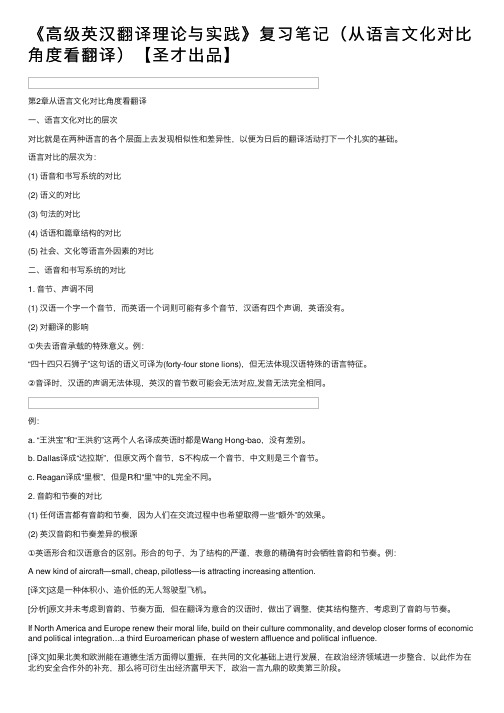
《⾼级英汉翻译理论与实践》复习笔记(从语⾔⽂化对⽐⾓度看翻译)【圣才出品】第2章从语⾔⽂化对⽐⾓度看翻译⼀、语⾔⽂化对⽐的层次对⽐就是在两种语⾔的各个层⾯上去发现相似性和差异性,以便为⽇后的翻译活动打下⼀个扎实的基础。
语⾔对⽐的层次为:(1) 语⾳和书写系统的对⽐(2) 语义的对⽐(3) 句法的对⽐(4) 话语和篇章结构的对⽐(5) 社会、⽂化等语⾔外因素的对⽐⼆、语⾳和书写系统的对⽐1. ⾳节、声调不同(1) 汉语⼀个字⼀个⾳节,⽽英语⼀个词则可能有多个⾳节,汉语有四个声调,英语没有。
(2) 对翻译的影响①失去语⾳承载的特殊意义。
例:“四⼗四只⽯狮⼦”这句话的语义可译为(forty-four stone lions),但⽆法体现汉语特殊的语⾔特征。
②⾳译时,汉语的声调⽆法体现,英汉的⾳节数可能会⽆法对应,发⾳⽆法完全相同。
例:a. “王洪宝”和“王洪豹”这两个⼈名译成英语时都是Wang Hong-bao,没有差别。
b. Dallas译成“达拉斯”,但原⽂两个⾳节,S不构成⼀个⾳节,中⽂则是三个⾳节。
c. Reagan译成“⾥根”,但是R和“⾥”中的L完全不同。
2. ⾳韵和节奏的对⽐(1) 任何语⾔都有⾳韵和节奏,因为⼈们在交流过程中也希望取得⼀些“额外”的效果。
(2) 英汉⾳韵和节奏差异的根源①英语形合和汉语意合的区别。
形合的句⼦,为了结构的严谨,表意的精确有时会牺牲⾳韵和节奏。
例:A new kind of aircraft—small, cheap, pilotless—is attracting increasing attention.[译⽂]这是⼀种体积⼩、造价低的⽆⼈驾驶型飞机。
[分析]原⽂并未考虑到⾳韵、节奏⽅⾯,但在翻译为意合的汉语时,做出了调整,使其结构整齐,考虑到了⾳韵与节奏。
If North America and Europe renew their moral life, build on their culture commonality, and develop closer forms of economic and political integration…a third Euroamerican phase of western affluence and political influence.[译⽂]如果北美和欧洲能在道德⽣活⽅⾯得以重振,在共同的⽂化基础上进⾏发展,在政治经济领域进⼀步整合,以此作为在北约安全合作外的补充,那么将可衍⽣出经济富甲天下,政治⼀⾔九⿍的欧美第三阶段。
上外“国外翻译研究丛书”清单(精)

上外“国外翻译研究丛书”清单(精)上海外语教育出版社“国外翻译研究丛书”清单1. Susan Bassnett & AndréLefevere Constructing Cultures: Essays on Literary Translation《文化构建:文学翻译论集》2. Basil Hatim Communication Across Cultures: Translation Theory andContrastive Text Linguistics《跨文化交际:翻译理论与对比篇章语言学》3. Christiane Nord Translating as a Purposeful Activity: FunctionalistApproaches Explained《目的性行为:析功能翻译理论》4. Leo Hickey (ed. The Pragmatics of Translation《语用学与翻译》5. Peter Newmark Approaches to Translation《翻译问题探讨》6. Wolfram Wilss The Science of Translation: Problems and Methods《翻译学:问题与方法》7. Peter Newmark A Textbook of Translation《翻译教程》8.Basil Hatim & Ian Mason Discourse and the Translator《语篇与译者》9. Eugene A. Nida Language and Culture: Contexts in Translating《语言与文化:翻译中的语境》10. Gideon T oury Descriptive Translation Studies and Beyond《描述翻译学及其他》11. George Steiner After Babel: Aspects of Language and Translation《通天塔之后:语言与翻译面面观》12. Mary Snell-Hornby Translation Studies: An Integrated Approach《翻译研究:综合法》13. Kathleen Davis Deconstruction and Translation《解构主义与翻译》14. Maria Tymoczko Translation in a Postcolonial Context: Early Irish Literature in English Translation《后殖民语境中的翻译:爱尔兰早期文学英译》15. David Katan Translating Cultures: An Introduction for Translators, Interpreters and Mediators《文化翻译:笔译、口译及中介入门》16. Theo Hermans Translation in Systems: Descriptive and System-oriented Approaches Explained《系统中的翻译:描写和系统理论解说》17. Luise von Flotow Translation and Gender: Translating in the ‘Era of Feminism’《翻译与性别:女性主义时代的翻译》18.Ernst-August Gutt Translation and Relevance: Cognition and Context《翻译与关联:认知与语境》19. Edwin Gentzler Contemporary Translation Theories (revised 2nd edition 《当代翻译理论》(第二版20. Mona Baker (ed. Routledge Encyclopedia of Translation Studies《翻译研究百科全书》21. Eugene A. Nida Toward a Science of Translating《翻译科学探索》22. Eugene A. Nida & Charles R. Taber The Theory and Practice of Translation 《翻译理论与实践》23. Andr⑥ Lefevere (ed. Translation/History/Culture: A Sourcebook《翻译、历史与文化论集》24. Andr⑥ Lefevere Translation, Rewriting, and the Manipulation of Literary Fame《翻译、改写以及对文学名声的制控》25. Katharina Reiss Translation Criticism: The Potentials and Limitations《翻译批评:潜力与制约》26. Lawrence Venuti The Translator’s Invisibility: A Hist ory of Translation《译者的隐身:一部翻译史》27. Susan Bassnett Translation Studies(3rd edition《翻译研究》(第三版28. Jenny Wil liams & Andrew Chesterman The Map: A Beginner’s Guide to Doing Research inTranslation Studies《路线图:翻译研究方法入门》29. Mark Shuttleworth & Moira Cowie Dictionary of Translation Studies《翻译学词典》。
翻译研究之2:跨文化交际—翻译理论与对比篇章语言学(Basil Hatim)

COMMUNICATION ACROSS CULTURES Translation Theory and Contrastive Text Linguistics跨文化交际----翻译理论与对比篇章语言学Basil Hatim出版前言这是一部将对比语言学、篇章语言学和翻译理论结合起来研究跨文化交际的学术专著。
作者巴兹尔•哈蒂姆是英国爱丁堡赫利奥特----沃特(Heriot-Watt)大学阿拉伯语研究中心主任,篇章语言学界的权威人士、著名理论家,一直走在该研究领域的前列。
本书是他长达10年的科研成果。
针对目前翻译理论、对比语言学、话语分析三个学科自成一体的学术局面,作者试图将三者融会贯通,明确提出在跨语言、跨文化的交际过程中,如果将母语语言、修辞的习惯表达应用与篇章转化,比如翻译实践当中,并在另一语言体系寻求对应表现法,其结果将是大有裨益的。
本专著共分17章。
全书说理透彻,脉络清晰。
首先,作者简单介绍了对比语言理论应用于翻译过程的可行性,即句法与语义性质等语言结构的重要意义,指出文本类型是进行上下文分析研究的中心课题,篇章才是有效信息交流的根本单位;进而,作者从功能语言学的角度,对修辞、文本风格、语域等因素进行了深入讨论。
由于阿拉伯语具有悠久独特的修辞风格,作者通过现在篇章语言学以及传统的阿拉伯语修辞学在语言研究分析中的有利地位,对篇章类型提出了自己的见解。
除此以外,作者还就文本类型、礼貌表达、交际文化、文学作品中的意识形态的分析与翻译、非小说类的散文文学中反语用法的翻译以及口译研究等问题从对比篇章语言学的角度进行了系统化的分析探讨。
本书贯穿书中的指导思想,就是将语篇分析的理论模型应用于笔译、口译及语言教学实践之中,并通过这些目标在实际中的结合来证明翻译的介绍可以加大对比语言学和语篇分析研究的广度和深度。
总之,本书论述系统全面,资料翔实,从理论到实践环环相扣,是一部侧重语言实际运用的学术著作,对于从事语言学、文学理论、话语分析、翻译以及文化等学科研究的人员提供了建设性的知道,是一本不可多得的好书。
跨文化交际中英文化对比课文参考译文U1
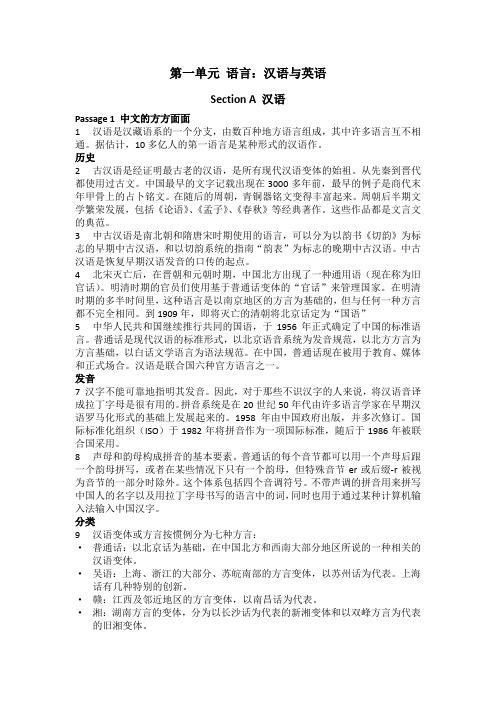
第一单元语言:汉语与英语Section A 汉语Passage 1 中文的方方面面1汉语是汉藏语系的一个分支,由数百种地方语言组成,其中许多语言互不相通。
据估计,10多亿人的第一语言是某种形式的汉语作。
历史2古汉语是经证明最古老的汉语,是所有现代汉语变体的始祖。
从先秦到晋代都使用过古文。
中国最早的文字记载出现在3000多年前,最早的例子是商代末年甲骨上的占卜铭文。
在随后的周朝,青铜器铭文变得丰富起来。
周朝后半期文学繁荣发展,包括《论语》、《孟子》、《春秋》等经典著作。
这些作品都是文言文的典范。
3中古汉语是南北朝和隋唐宋时期使用的语言,可以分为以韵书《切韵》为标志的早期中古汉语,和以切韵系统的指南“韵表”为标志的晚期中古汉语。
中古汉语是恢复早期汉语发音的口传的起点。
4北宋灭亡后,在晋朝和元朝时期,中国北方出现了一种通用语(现在称为旧官话)。
明清时期的官员们使用基于普通话变体的“官话”来管理国家。
在明清时期的多半时间里,这种语言是以南京地区的方言为基础的,但与任何一种方言都不完全相同。
到1909年,即将灭亡的清朝将北京话定为“国语”5中华人民共和国继续推行共同的国语,于1956年正式确定了中国的标准语言。
普通话是现代汉语的标准形式,以北京语音系统为发音规范,以北方方言为方言基础,以白话文学语言为语法规范。
在中国,普通话现在被用于教育、媒体和正式场合。
汉语是联合国六种官方语言之一。
发音7 汉字不能可靠地指明其发音。
因此,对于那些不识汉字的人来说,将汉语音译成拉丁字母是很有用的。
拼音系统是在20世纪50年代由许多语言学家在早期汉语罗马化形式的基础上发展起来的。
1958年由中国政府出版,并多次修订。
国际标准化组织(ISO)于1982年将拼音作为一项国际标准,随后于1986年被联合国采用。
8声母和韵母构成拼音的基本要素。
普通话的每个音节都可以用一个声母后跟一个韵母拼写,或者在某些情况下只有一个韵母,但特殊音节er或后缀-r被视为音节的一部分时除外。
上外“国外翻译研究丛书”清单

上海外语教育出版社“国外翻译研究丛书”清单1. Susan Bassnett & AndréLefevere Constructing Cultures: Essays on Literary Translation《文化构建:文学翻译论集》2. Basil Hatim Communication Across Cultures: Translation Theory andContrastive Text Linguistics《跨文化交际:翻译理论与对比篇章语言学》3. Christiane Nord Translating as a Purposeful Activity: FunctionalistApproaches Explained《目的性行为:析功能翻译理论》4. Leo Hickey (ed.) The Pragmatics of Translation《语用学与翻译》5. Peter Newmark Approaches to Translation《翻译问题探讨》6. Wolfram Wilss The Science of Translation: Problems and Methods《翻译学:问题与方法》7. Peter Newmark A Textbook of Translation《翻译教程》8.Basil Hatim & Ian Mason Discourse and the Translator《语篇与译者》9. Eugene A. Nida Language and Culture: Contexts in Translating《语言与文化:翻译中的语境》10. Gideon Toury Descriptive Translation Studies and Beyond《描述翻译学及其他》11. George Steiner After Babel: Aspects of Language and Translation《通天塔之后:语言与翻译面面观》12. Mary Snell-Hornby Translation Studies: An Integrated Approach《翻译研究:综合法》13. Kathleen Davis Deconstruction and Translation《解构主义与翻译》14. Maria Tymoczko Translation in a Postcolonial Context: Early IrishLiterature in English Translation《后殖民语境中的翻译:爱尔兰早期文学英译》15. David Katan Translating Cultures: An Introduction for Translators,Interpreters and Mediators《文化翻译:笔译、口译及中介入门》16. Theo Hermans Translation in Systems: Descriptive and System-orientedApproaches Explained《系统中的翻译:描写和系统理论解说》17. Luise von Flotow Translation and Gender: Translating in the ‘Era ofFeminism’《翻译与性别:女性主义时代的翻译》18.Ernst-August Gutt Translation and Relevance: Cognition and Context《翻译与关联:认知与语境》19. Edwin Gentzler Contemporary Translation Theories (revised 2nd edition)《当代翻译理论》(第二版)20. Mona Baker (ed.) Routledge Encyclopedia of Translation Studies《翻译研究百科全书》21. Eugene A. Nida Toward a Science of Translating《翻译科学探索》22. Eugene A. Nida & Charles R. Taber The Theory and Practice of Translation《翻译理论与实践》23. Andr⑥ Lefevere (ed.) Translation/History/Culture: A Sourcebook《翻译、历史与文化论集》24. Andr⑥ Lefevere Translation, Rewriting, and the Manipulation of LiteraryFame《翻译、改写以及对文学名声的制控》25. Katharina Reiss Translation Criticism: The Potentials and Limitations《翻译批评:潜力与制约》26. Lawrence Venuti The Translator’s Invisibility: A History of Translation《译者的隐身:一部翻译史》27. Susan Bassnett Translation Studies(3rd edition)《翻译研究》(第三版)28. Jenny Williams & Andrew Chesterman The Map: A Beginner’s Guide to Doing Research inTranslation Studies《路线图:翻译研究方法入门》29. Mark Shuttleworth & Moira Cowie Dictionary of Translation Studies《翻译学词典》。
语篇与译者
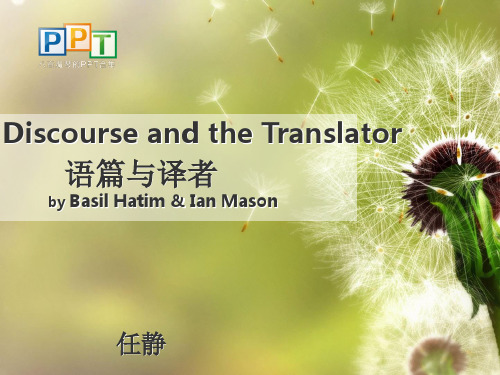
八音魔琴PPT教程系列
-10-
The emergence of linguistics as a new discipline in the twentieth century brought a spirit of optimism to the pursuit of language study ,a feeling that the groundwork was at last being laid for a systematic and scientific approach to the description of language. Perhaps provide solutions to the kinds of language problems one obvious application of linguistics: develop a device for carrying out automatic translation
Discourse and the Translator(written in collaboration with Ian Mason) Communication across Cultures :Translation theory and Contrastive text
《跨文化交际-翻译理论与对比篇章语言学》 Ian Mason is a Professor of Interpreting and Translating at Heriot-Watt University. Among his publications is the Discourse and the Translator,written in collaboration with Basil Hatim Another Book:Dialogue Interpreting
(完整版)国外翻译研究丛书-书目(截至2016.8)

&AndréLefevere
Constructing Cultures: Essays on Literary Translation
《文化构建:文学翻译论集》
2
Basil Hatim
CommunicationacrossCultures: Translation TheoryandContrastive Text Linguistics
《中国翻译话语英译选集(上册)从最早期到佛典翻译》
32
Jeremy Munday
Introducing Translation Studies
《翻译研究入门:理论与应用》
33
Basil Hatim
&Jeremy Munday
Translation: An Advanced Resource Book
《后殖民语境中的翻译:爱尔兰早期文学英译》
15
David Katan
Translating Cultures: An Introduction for Translators, InterpretersandMediators
《文化翻译:笔译、口译及中介入门》
16
Theo Hermans
Translation in Systems: Descriptive and System-oriented Approaches Explained
《描述翻译学及其他》
11
George Steiner
AfterBabel: Aspects of LanguageandTranslation
《通天塔之后:语言与翻译面面观》
翻译理论与实践研究参考文献
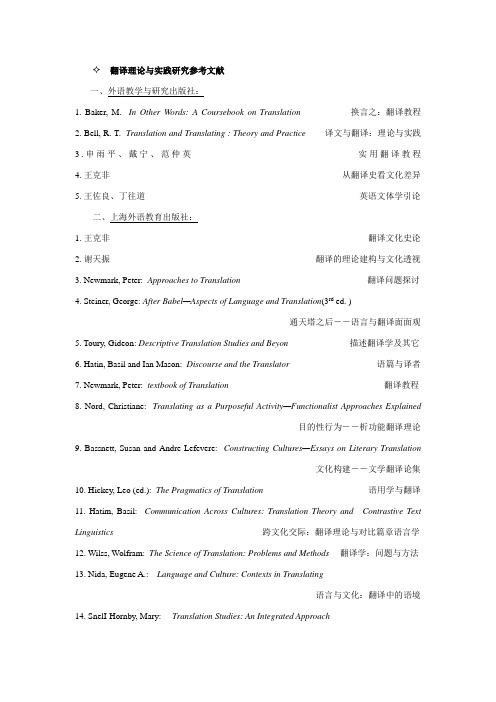
翻译理论与实践研究参考文献一、外语教学与研究出版社:1. Baker, M. In Other Words: A Coursebook on Translation 换言之:翻译教程2. Bell, R. T. Translation and Translating : Theory and Practice译文与翻译:理论与实践3.申雨平、戴宁、范仲英实用翻译教程4. 王克非从翻译史看文化差异5. 王佐良、丁往道英语文体学引论二、上海外语教育出版社:1. 王克非翻译文化史论2. 谢天振翻译的理论建构与文化透视3. Newmark, Peter: Approaches to Translation翻译问题探讨4. Steiner, George: After Babel—Aspects of Language and Translation(3rd ed. )通天塔之后――语言与翻译面面观5. Toury, Gideon: Descriptive Translation Studies and Beyon 描述翻译学及其它6. Hatin, Basil and Ian Mason: Discourse and the Translator语篇与译者7. Newmark, Peter: textbook of Translation 翻译教程8. Nord, Christiane: Translating as a Purposeful Activity—Functionalist Approaches Explained目的性行为――析功能翻译理论9. Bassnett, Susan and Andre Lefevere: Constructing Cultures—Essays on Literary Translation文化构建――文学翻译论集10. Hickey, Leo (ed.): The Pragmatics of Translation语用学与翻译11. Hatim, Basil: Communication Across Cultures: Translation Theory and Contrastive Text Linguistics跨文化交际:翻译理论与对比篇章语言学12. Wilss, Wolfram: The Science of Translation: Problems and Methods 翻译学:问题与方法13. Nida, Eugene A.:Language and Culture: Contexts in Translating语言与文化:翻译中的语境14. SnelI-Hornby, Mary: Translation Studies: An Integrated Approach翻译研究:综合法15. Davis, Kathleen: Deconstruction and Translation 解构主义与翻译16. Hermans, Thee: Translation in Systems: Descriptive and System Oriented Approaches Explained 系统中的翻译:描写和系统理论解说17. Gull, Ernst-August: Translation and Relevance Cognition and Context翻译与关联:认知与语境18. Gentzler, Edwin: Contemporary Translation Theories (revised 2nd editio)当代翻译理论(第二版)19. Baker, Mona (ed.): Routledge Encyclopedia of Translation Studies翻译研究百科全书20. Nida, Eugene A.: Toward a Science of Translating 翻译科学探索21. Nida, Eugene A. & Charles R.:The Theory and Practice of Translation翻译理论与实践22. Lefevere, Andre (ed.): Translation/History/Culture: A Sourcebook 翻译、历史与文化论集23. Reiss, Katharina: Translation Criticism: The Potentials and Limitations翻译批评:潜力与制约24. Venuti, Lawrence:The Translator's Invisibility: A History of Translation译者的隐身:一部翻译史25. Bassnett, Susan: Translation Studies (3rd edition) 翻译研究(第三版)26. Williams, Jenny & Andrew Chesterman:The Map: A Beginner's Guide to Doing Research in Translation Studies 路线图:翻译研究方法入门27. Shullleworth, Mark & Moira: Dictionary of Translation Studies翻译学词典三、中国对外翻译出版公司:翻译理论与实务丛书(罗进德主编)1. 马祖毅著中国翻译简史——五四以前部分(增订版)2. 金 著等效翻译探索 (增订版)3. 刘宓庆著文体与翻译 (增订版)4. 金圣华、黄国彬主编困难见巧——名家翻译经验谈5.周兆祥著翻译与人生6.陈生保编著英汉科技翻译指要7. 冯志杰著汉英科技翻译指要8. 陈忠诚著法窗译话9. 刘重德编著文学翻译十讲10. 陈定安编著英汉比较与翻译11. 谭载喜编著新编奈达论翻译12. 刘宓庆著当代翻译理论13. 郭建中编文化与翻译14. 陈忠诚著词语翻译丛谈15. 陈忠诚、吴幼娟著词语翻译丛谈续编16. 贾文波著汉英时文翻译17. 黄忠廉著翻译变体研究18. 马红军著翻译批评散论19.思果著翻译新究20. 李运兴著语篇翻译引论21. 包惠南著文化语境与语言翻译22. 刘宓庆著翻译与语言哲学23. 萧立明著新译学论稿四、其它:1. 《翻译论集》罗新璋编,商务印书馆,1984年版2. 《中国翻译史》(上卷) 马祖毅著,湖北教育出版社,1999年版3. 《西方翻译简史》谭载喜著,商务印书馆,1991年版4. 《外国翻译理论评介文集》中国对外翻译出版公司编印,1984年版5. 《奈达论翻译》谭载喜编译,中国对外翻译出版公司,1984年版6. 《语言与翻译》[苏]巴尔胡达罗夫著,蔡毅、虞杰、段京华编译,中国对外翻译出版公司,1985年版7. 《文体与翻译》刘宓庆著,中国对外翻译出版公司,1986年版8. 《习语汉译英研究》张培基编,商务印书馆,1979年版9. 《英汉翻译教程》张培基等编著,上海外语教育出版社,1980年版10. 《英汉翻译手册》钟述孔著,商务印书馆,1980年版11. 《翻译的技巧》钱歌川著,台湾开明书店印行,1972年版12. 《翻译漫谈》钱歌川著,中国对外翻译出版公司,1980年版13. 《科技翻译工作手册》李维颐等编,天津科学技术出版社,1986年版14. 《长安译论》王宏印主编,陕西旅游出版社,2000年版15. 《跨语交际》谭载喜编译,漓江出版社,1993年版16. 《语言论——言语研究导论》[美]爱德华·萨丕尔著,陆卓元译,商务印书馆,1997年版17. 《句法理论的若干问题》[美]诺姆·乔姆斯基著,黄长著、林书武、沈家煊译,中国社会科学出版社,1986年版18. 《意义的探究——当代西方释义学》张汝伦著,辽宁人民出版社,1986年版英汉翻译常用工具书(一)英汉类1.《新英汉词典》(增补本) 《新英汉词典》编写组编,上海译文出版社,1986年版2.《英华大辞典》(修订第二版) 郑易里等编并修订,商务印书馆,1984年版3.《英汉大辞典》(缩印本) 陆谷孙主编,上海译文出版社,1993年版4.《远东英汉大辞典》梁实秋主编,远东图书公司印行,1977年版5.《最新高级英汉词典》蔡文萦主编,李赋宁审校,商务印书馆国际有限公司,1994年版(二)汉英类1.《汉英词典》(修订版)、北京外国语大学英语系词典组编,外语教学与研究出版社,l 995年版2.《汉英大辞典》(上、下卷) 吴光华主编,上海交通大学出版社,1993年版3.《远东汉英大辞典》梁实秋原主编,张芳杰主编,新华出版社,远东图书公司,1995年版(三)英语类1.Longman Dicitonary of Contemporary Englis h,Longman Group Limited.19782.Chambers Twentieth Century Dictionary,new ed.,Edinburgh & London,1972.3.The American Heritage Dictionary of the English Language,New York.19754.Webster’s Third New International Dictionary of the English Language,Springfield,Mass.,1961(Addenda 1966),19715.6,000 words:A Supplement to Webster’s Third New International Dictionary,Springfield,Mass.,19766.ORIGINS An Etymological Dictionary of Modern Englis h,by Eric Partridge,London,1990(四)汉语类1.《现代汉语词典》商务印书馆,1970年版2.《现代汉语词林》(正反序编排) 福建人民出版社,1986年版3.《汉语大字典》(缩印本)《汉语大字典》编委会,四川辞书出版社、湖北辞书出版社,1993年版4.《古代汉语词典》《古代汉语词典》编写组,商务印书馆,1998年版(五)专名类1.《英语姓名译名手册》(第二次修订本) 新华通讯社译名资料组编,商务印书馆,1985年版2.《世界姓名译名手册》《世界姓名译名手册》编译组编,化学工业出版社,1987年版3.《外国地名译名手册》中国地名委员会编,商务印书馆,1983年版4.《世界地名译名手册》辛华编,商务印书馆,1978年版5.《世界报刊、通讯社、电台译名手册》(修订本) 辛华编,商务印书馆;1978年版(六)略语类1.《英汉缩略语词典》西安外国语学院英语系《英汉缩略语词典》编写组,陕西人民出版社,1980年版2.《英语缩略词词典》史群编,商务印书馆,1979年版(七)科技类1.《英汉技术词典》清华大学《英汉技术词典》编写组编,国防工业出版社,1978年版2.《英汉科技缩写词汇》阎庆甲编,冶金工业出版社,1981年版3.《科技翻译工作手册》李维颐等编,天津科学技术出版社,1986年版(八)史地类1.《世界历史词典》勒文翰、郭圣铭、孙道天主编,上海辞书出版社,1985年版2.《外国历史大事年表》(公元前4500年一公元1945年) 王治邦、曲培洛、唐承运、于庆和、王永本编,辽宁人民出版社,1985年版3.《世界现代史大事记》吴成平编著,知识出版社,1984年版4.《美国两百年大事记》[美]加尔文·D·林顿编著,谢延光、储复耘、容再光、李祥荣译,上海译文出版社,1984年版5.《各国概况》(1979年版) 《各国概况》编辑组编,世界知识出版社,1979年版(九)百科类1.《辞海》(缩印本) 《辞海》编辑委员会编,上海辞书出版社,1989年版2.《辞源》(修订本) (1—4合订本)商务印书馆,1989年版3.《简明不列颠百科全书》(十卷本) 《简明不列颠百科全书》编辑部译编,中国大百科全书出版社,1986年版4.《中国大百科全书》(多卷本) 中国大百科全书出版社,1982年版。
跨文化交际与翻译
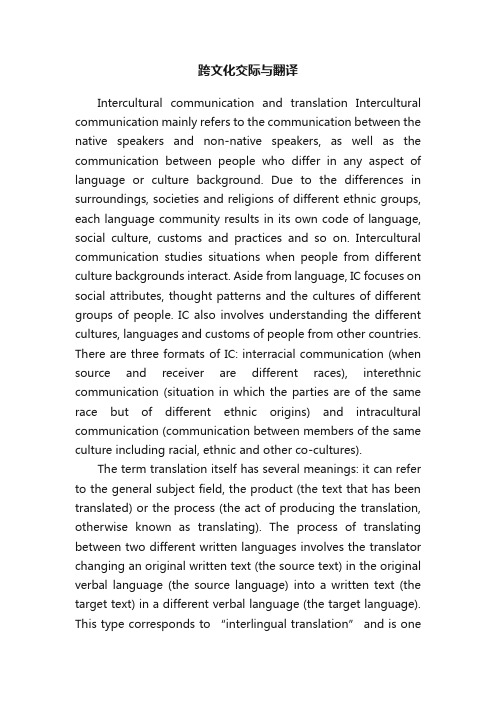
跨文化交际与翻译Intercultural communication and translation Intercultural communication mainly refers to the communication between the native speakers and non-native speakers, as well as the communication between people who differ in any aspect of language or culture background. Due to the differences in surroundings, societies and religions of different ethnic groups, each language community results in its own code of language, social culture, customs and practices and so on. Intercultural communication studies situations when people from different culture backgrounds interact. Aside from language, IC focuses on social attributes, thought patterns and the cultures of different groups of people. IC also involves understanding the different cultures, languages and customs of people from other countries. There are three formats of IC: interracial communication (when source and receiver are different races), interethnic communication (situation in which the parties are of the same race but of different ethnic origins) and intracultural communication (communication between members of the same culture including racial, ethnic and other co-cultures).The term translation itself has several meanings: it can refer to the general subject field, the product (the text that has been translated) or the process (the act of producing the translation, otherwise known as translating). The process of translating between two different written languages involves the translator changing an original written text (the source text) in the original verbal language (the source language) into a written text (the target text) in a different verbal language (the target language). This type corresponds to “interlingual translation” and is oneof the three Roman Jakobson in his seminal paper. Jakobson’s categories are: 1. Intralingual translation, or “rewording”– an interpretation of verbal signs by means of other signs of the same language; 2. Interlingual translation, or “translation proper”–an interpretation of verbal signs by means of some other language; 3. Intersemiotic translation, or “transmutation”– an interpretation of verbal signs by means of signs of non-verbal sign systems. Intralingual translation would occur when we rephrase an expression or text in the same language to explain or clarify something we might have said or written. Intersemiotic translation would occur if a written text were translated, for example, into music, film or painting. It is interlingual translation which is the traditional, although by no means exclusive, focus of translation studies.It is easily seen that the three forms of intercultural communication and the three types of translation are partly corresponding to each other, especially interracial communication and interlingual translation which both attach attention on the communication between native and non-native, and where different cultures of different countries play more important role. To conduct effective intercultural communication, one has to understand the differences between the different nations and then to look for them and pay attention to in every cross-cultural communication situation. By doing this, the high-context communicators can learn to use and respond words, emotions, postures differently, and low-context communicators can learn topay attention to context and learn to interpret meaning in terms of the context. It is evident that different countries or nations have quite different customs, cultures, ways to expressemotions and so on, to become successful communicator and avoid serious culture shock and failure, it’s essential to have intercultural knowledge about low context, high context, power distance and other information, to eradicate stereotypes, to hold placid attitude, to know that cultures are different.And there was no doubting translation is an intercultural activity. The culture of source text can only find echoes from source language readers, however, for target language readers, the lack of similar cultural background may lead to the loss of ingenuity of the originals. Translation as a tool of communication is thus a significant intercultural activity aiming at breaking the language and culture barriers and enriching communication. To become a successful translator or interpreter, learning culture difference is an inevitable aspect of training. Translation texts are the product of the mutual influence of source language culture and target language culture. The properties, extent and concrete level of the two languages and cultures are to some degree influencing the choice of translation strategies, syntactic structures and words of the translators. Thus culture as a dispensable capability of a translator, of conducting effective translation makes translation resemble to intercultural communication.Effective intercultural communication cannot be accomplished at one stroke, and it is impossible to do successful translation without knowledge of cultures. To stride across the cultural barriers of different nati ons, it’s necessary to adjust the attitude of intercultural communication, and recognize the discrepancy of translation strategies, so to reconstruct the artistic sense of originals, and appeal to more target readers with vigorous translation. Knowing better the relationship betweenintercultural communication and translation is of great importance to these two practices.。
浅析对比语言学在跨文化交际中的应用论文
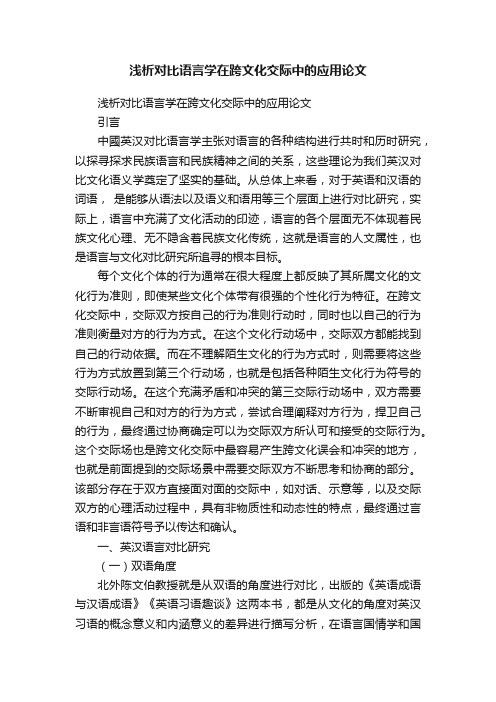
浅析对比语言学在跨文化交际中的应用论文浅析对比语言学在跨文化交际中的应用论文引言中國英汉对比语言学主张对语言的各种结构进行共时和历时研究,以探寻探求民族语言和民族精神之间的关系,这些理论为我们英汉对比文化语义学奠定了坚实的基础。
从总体上来看,对于英语和汉语的词语,是能够从语法以及语义和语用等三个层面上进行对比研究,实际上,语言中充满了文化活动的印迹,语言的各个层面无不体现着民族文化心理、无不隐含着民族文化传统,这就是语言的人文属性,也是语言与文化对比研究所追寻的根本目标。
每个文化个体的行为通常在很大程度上都反映了其所属文化的文化行为准则,即使某些文化个体带有很强的个性化行为特征。
在跨文化交际中,交际双方按自己的行为准则行动时,同时也以自己的行为准则衡量对方的行为方式。
在这个文化行动场中,交际双方都能找到自己的行动依据。
而在不理解陌生文化的行为方式时,则需要将这些行为方式放置到第三个行动场,也就是包括各种陌生文化行为符号的交际行动场。
在这个充满矛盾和冲突的第三交际行动场中,双方需要不断审视自己和对方的行为方式,尝试合理阐释对方行为,捍卫自己的行为,最终通过协商确定可以为交际双方所认可和接受的交际行为。
这个交际场也是跨文化交际中最容易产生跨文化误会和冲突的地方,也就是前面提到的交际场景中需要交际双方不断思考和协商的部分。
该部分存在于双方直接面对面的交际中,如对话、示意等,以及交际双方的心理活动过程中,具有非物质性和动态性的特点,最终通过言语和非言语符号予以传达和确认。
一、英汉语言对比研究(一)双语角度北外陈文伯教授就是从双语的角度进行对比,出版的《英语成语与汉语成语》《英语习语趣谈》这两本书,都是从文化的角度对英汉习语的概念意义和内涵意义的差异进行描写分析,在语言国情学和国俗语义学理论的指导下,一些外语工作者纷纷从事汉外的国俗语义词语对比研究,探索两种(或更多)语言中民族文化词语所包含的语言文化现象并总结其中的异同,帮助学生在学习外语词汇概念意义的同时了解其民族文化涵义。
跨文化交际中英汉概念隐喻的对比研究

跨文化交际中英汉概念隐喻的对比研究1. 引言1.1 研究背景在当今全球化的背景下,跨文化交际已经成为一个日益重要的课题。
随着经济、政治、文化的全球互动日益频繁,不同文化之间的交流与融合变得愈发紧密。
在这种情况下,人们不仅需要具备跨文化交际的能力,更需要深入理解不同文化之间的隐喻概念,以避免语言、文化误解,促进有效的沟通与合作。
本研究旨在探讨跨文化交际中英汉概念隐喻的差异和联系,从而为促进不同文化之间的交流与理解提供理论支持和实践指导。
通过对英汉文化中概念隐喻的对比研究,可以加深我们对语言、文化和思维方式的认识,拓展跨文化交际领域的研究视野,为构建和谐的国际关系做出贡献。
【2000字】1.2 研究目的跨文化交际中英汉概念隐喻的对比研究旨在深入探讨不同语言和文化背景下概念隐喻的表达方式和传达方式的差异。
具体目的包括:一、分析英汉两种语言中常用的概念隐喻,探讨其特点和应用领域;二、比较英汉两种语言中同一概念的隐喻表达方式的异同,找出存在的差异和难点;三、探讨跨文化交际过程中概念隐喻可能产生的误解和挑战,并提出有效的应对策略;四、总结研究结果,为增进不同文化间的理解和沟通提供理论支持和实践指导。
通过对英汉概念隐喻的比较研究,可以进一步促进跨文化交际中语言和文化之间的互学互鉴,提升交流双方的语言表达能力和文化适应能力,达到促进文化交流、增进友谊和促进世界和平的目的。
1.3 研究意义跨文化交际中英汉概念隐喻的对比研究具有重要的研究意义。
隐喻是人类思维和语言的重要组成部分,通过对跨文化交际中英汉概念隐喻的对比研究,可以深入探讨不同文化背景下的思维方式和语言表达方式的异同,有助于增进对两种语言和文化的理解和尊重。
隐喻在跨文化交际中扮演着重要的角色,对于语言学习者和翻译工作者来说,了解英汉概念隐喻的区别可以帮助他们更准确地理解和表达意思,避免因文化差异而引起的误解或误译。
通过对英汉概念隐喻的比较研究,可以深化我们对不同文化中思维模式和认知方式的理解,拓展我们的跨文化交际视野,提高我们的跨文化交际能力。
翻译对二语习得与跨文化交际的影响研究
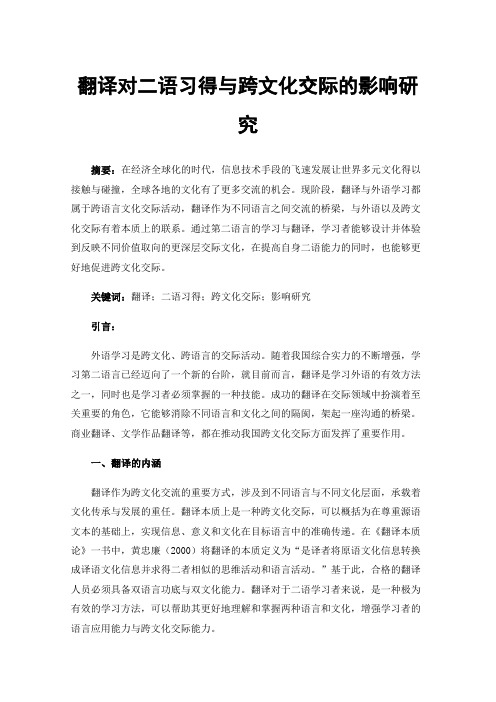
翻译对二语习得与跨文化交际的影响研究摘要:在经济全球化的时代,信息技术手段的飞速发展让世界多元文化得以接触与碰撞,全球各地的文化有了更多交流的机会。
现阶段,翻译与外语学习都属于跨语言文化交际活动,翻译作为不同语言之间交流的桥梁,与外语以及跨文化交际有着本质上的联系。
通过第二语言的学习与翻译,学习者能够设计并体验到反映不同价值取向的更深层交际文化,在提高自身二语能力的同时,也能够更好地促进跨文化交际。
关键词:翻译;二语习得;跨文化交际;影响研究引言:外语学习是跨文化、跨语言的交际活动。
随着我国综合实力的不断增强,学习第二语言已经迈向了一个新的台阶,就目前而言,翻译是学习外语的有效方法之一,同时也是学习者必须掌握的一种技能。
成功的翻译在交际领域中扮演着至关重要的角色,它能够消除不同语言和文化之间的隔阂,架起一座沟通的桥梁。
商业翻译、文学作品翻译等,都在推动我国跨文化交际方面发挥了重要作用。
一、翻译的内涵翻译作为跨文化交流的重要方式,涉及到不同语言与不同文化层面,承载着文化传承与发展的重任。
翻译本质上是一种跨文化交际,可以概括为在尊重源语文本的基础上,实现信息、意义和文化在目标语言中的准确传递。
在《翻译本质论》一书中,黄忠廉(2000)将翻译的本质定义为“是译者将原语文化信息转换成译语文化信息并求得二者相似的思维活动和语言活动。
”基于此,合格的翻译人员必须具备双语言功底与双文化能力。
翻译对于二语学习者来说,是一种极为有效的学习方法,可以帮助其更好地理解和掌握两种语言和文化,增强学习者的语言应用能力与跨文化交际能力。
二、翻译与二语习得以及跨文化交际的关系翻译和二语习得在本质上与跨文化交际紧密相连。
二语习得的过程实际上是利用语言教学工具,在不同的文化体系和意识形态之间探索目标语言所承载的社会文化内涵,从而实现文化传递与诠释。
跨文化交际是一个特定的概念,既包括本族语者与非本族语者之间的交流,也包括在语言和文化背景方面存在差异的人们之间的交际。
翻译与跨文化交际 第二章
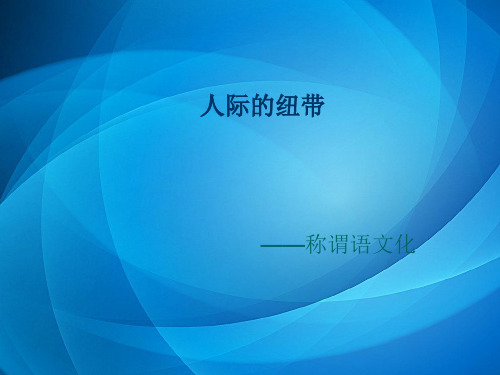
译文赏析
原文: 你只叫他‘凤辣子’ 就是了。 (Para. 2)
霍译: You just call her “Peppercorn Feng” .
杨译: Just call her Fiery Phoenix.
“辣子”,“凤辣子”:在中 国文化中辣子用来形容一个 性格泼辣,行事雷厉风行的 人物,在这里是贾母对王熙 凤的昵称。杨宪益和霍克斯 的译文均使用了“pepper”能 够很好地保留原中的文化意 象“辣子”。杨译本同时加 上了修饰的词汇“hot”以及 “fiery”,很容易让读者将辣 子的特性和人的性格联系起 来。
侄女”很显然不是用niece 就能准确描述的。
译文赏析
原文:竟不像老祖宗的外孙女 老祖宗:在中国古语中,老
儿 (Para. 2)
祖宗有其特殊内涵,它象征
着这个人的社会身份和地位,
在《红楼梦》中指贾府的最
高身份的掌管者,杨宪益的
霍译: She doesn’t take after your side of the family, Grannie.
译文赏析
原文:况且这通身的气派,竟 不像老祖宗的外孙女儿,竟 是个嫡亲的孙女 (Para. 2)
霍译: …She’s more like a Jia.
杨译: …She doesn’t take after her father, son-in-law of our Old Ancestress, but looks more like a Chia.
译文赏析
原文:大舅贾赦之子贾琏,娶 的就是二舅母王氏之内侄女
(Para. 2)
“内侄女”不同于“侄女”, 在亲属的关系中指母亲这 边的远房亲戚而“侄女”
- 1、下载文档前请自行甄别文档内容的完整性,平台不提供额外的编辑、内容补充、找答案等附加服务。
- 2、"仅部分预览"的文档,不可在线预览部分如存在完整性等问题,可反馈申请退款(可完整预览的文档不适用该条件!)。
- 3、如文档侵犯您的权益,请联系客服反馈,我们会尽快为您处理(人工客服工作时间:9:00-18:30)。
COMMUNICATION ACROSS CULTURES Translation Theory and Contrastive Text Linguistics跨文化交际----翻译理论与对比篇章语言学Basil Hatim出版前言这是一部将对比语言学、篇章语言学和翻译理论结合起来研究跨文化交际的学术专著。
作者巴兹尔•哈蒂姆是英国爱丁堡赫利奥特----沃特(Heriot-Watt)大学阿拉伯语研究中心主任,篇章语言学界的权威人士、著名理论家,一直走在该研究领域的前列。
本书是他长达10年的科研成果。
针对目前翻译理论、对比语言学、话语分析三个学科自成一体的学术局面,作者试图将三者融会贯通,明确提出在跨语言、跨文化的交际过程中,如果将母语语言、修辞的习惯表达应用与篇章转化,比如翻译实践当中,并在另一语言体系寻求对应表现法,其结果将是大有裨益的。
本专著共分17章。
全书说理透彻,脉络清晰。
首先,作者简单介绍了对比语言理论应用于翻译过程的可行性,即句法与语义性质等语言结构的重要意义,指出文本类型是进行上下文分析研究的中心课题,篇章才是有效信息交流的根本单位;进而,作者从功能语言学的角度,对修辞、文本风格、语域等因素进行了深入讨论。
由于阿拉伯语具有悠久独特的修辞风格,作者通过现在篇章语言学以及传统的阿拉伯语修辞学在语言研究分析中的有利地位,对篇章类型提出了自己的见解。
除此以外,作者还就文本类型、礼貌表达、交际文化、文学作品中的意识形态的分析与翻译、非小说类的散文文学中反语用法的翻译以及口译研究等问题从对比篇章语言学的角度进行了系统化的分析探讨。
本书贯穿书中的指导思想,就是将语篇分析的理论模型应用于笔译、口译及语言教学实践之中,并通过这些目标在实际中的结合来证明翻译的介绍可以加大对比语言学和语篇分析研究的广度和深度。
总之,本书论述系统全面,资料翔实,从理论到实践环环相扣,是一部侧重语言实际运用的学术著作,对于从事语言学、文学理论、话语分析、翻译以及文化等学科研究的人员提供了建设性的知道,是一本不可多得的好书。
ContentsFigures----------------------------------------------------------------------------vii Preface-----------------------------------------------------------------------------ix Arabic Transliteration System--------------------------------------------------xi Introduction----------------------------------------------------------------------xiii Chapter1 Contrastive linguistic decisions: the need for Textual competence-------------------------------------------------------------------------1 Chapter2 Foundation disciplines-----------------------------------------------13 Chapter3 The myth of the single register-------------------------------------22 Chapter4.Argumentation across culture--------------------------------------35 Chapter5 Argumentation in Arabic rhetoric----------------------------------47 Chapter6 The paragraph as a unit of text structure--------------------------54 Chapter7 Background information in expository text----------------------65 Chapter8 At the interface between structure and texture: the Textual progression of themes and rhemes---------------------------------------------76 Chapter9 Cataphora as a textural manifestation-----------------------------89 Chapter10 Degree of texture ex; licitness------------------------------------99 Chapter11 Emotiveness in texts----------------------------------------------111 Chapter12 Translating direct speech and the dynamics of news Reporting------------------------------------------------------------------------123Chapter13 The pragmatics of politeness------------------------------------139 Chapter14 Culture in contact-------------------------------------------------157CONTENTSChapter15 The discourse of the alienate------------------------------------174 Chapter16 The translation of irony: a discourse Perspective----------------------------------------------------------------------186 Chapter17 Th e ‘other’texts: implications for liaison Interpreting----------------------------------------------------------------------206 Glossary of Contrastive Text Linguistics and Translation Terms-----------------------------------------------------------------------------213 References-----------------------------------------------------------------------226 Index-----------------------------------------------------------------------------231Figures3.1 The three dimensions of context ----------------------------------------- 22 3.2 Tenor v. field and mode --------------------------------------------------- 26 3.3 The semiotics of field, mode and tenor --------------------------------- 293.4 Deeper levels of semiotics ------------------------ ------------------------314.1 Basic text types ---------------------------------- ---------------------------39 4.2 Through-argumentation ----------------------------------------------------39 4.3 Counter-argumentation ---------------------------------------------------- 404.4 Order of text-type preference ---------------------- ----------------------44 6.1 The negotiation of text structure ----------------------------------------- 55 6.2 A possible context -------------------------------- --------------------------56 6.3 Negotiating a structural format—the basic level of Elements ------------------------------------------ -------------------------------------------57 6.4 Negotiating a structural format—the basic level of Chunks ------------------------------------------------------------------------------------- 576.5 The structural organization of sample B ----------- ---------------------617.1 Exposition ---------------------------------------- ---------------------------66 7.2 Add-on background information ----------------------------------------- 68 7.3 Three levels of narration -------------------------------------------------- 71 7.4 Main and subordinate texts ------------------------ -----------------------737.5 Background signals in embedded texts -------------- -------------------748.1 Simile linear TP----------------------------------- --------------------------81 8.2 Continuous-theme TP ----------------------------------------------------- 81FIGURES8.3 The tone-setter and the scene setter ------------------------------------- 838.4 The zigzag and the uniform patterns --------------- ---------------------859.1 Argumentation and exposition ---------------------- ---------------------91 9.2 Cataphora in argumentation ------------------------ ----------------------93 9.3 Cataphora in exposition --------------------------------------------------- 9412.1 Contextural profile sample A------------------------------------------ 126 12.2 Speech act sequence for Part V sample A --------------------------- 130 12.3 Text structure of sample A ---------------------- -----------------------13412.4 Text-discourse-genre chain -------------------------------------------- 13513.1 Text type token relationship in text ----------------------------------- 14013.2 Text-type, Power and Distance ---------------------------------------- 15614.1 The-type continuum ---------------------------------------------------- 168 17.1 Intertextual retrieval -------------------------- --------------------------203。
